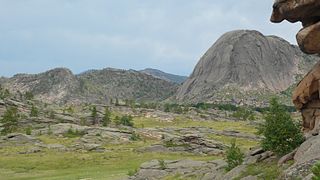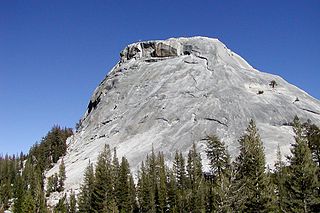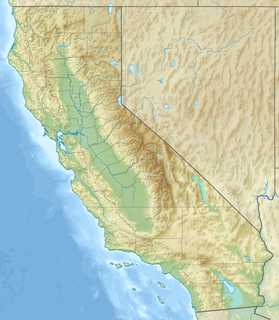| Pothole Dome | |
|---|---|
 | |
| Highest point | |
| Elevation | 8765+ ft (2671+ m) NAVD 88 [1] |
| Coordinates | 37°52′48″N119°23′36″W / 37.8799245°N 119.3932138°W Coordinates: 37°52′48″N119°23′36″W / 37.8799245°N 119.3932138°W [2] |
| Geography | |
| Location | Tuolumne County, California, U.S. |
| Parent range | Sierra Nevada |
| Topo map | USGS |
| Climbing | |
| Easiest route | Hide, class 1 |
Pothole Dome is a granite dome on the west side of Tuolumne Meadows, in Yosemite National Park. [1] Near Pothole Dome is Marmot Dome. [3] The summit of the dome is easily accessible by foot from a parking area on the Tioga Road. The view from the summit includes most of Tuolumne Meadows and in the distance, Cathedral Peak. [4] The dome gives evidence of many of the geologic processes at work in Yosemite during and after the last ice age. In particular, the stranded, rounded boulders from a glacier that has long since retreated, and the water-eroded "potholes" provide evidence of two ways that water can interact with granite. [5]

Granite domes are domical hills composed of granite with bare rock exposed over most of the surface. Generally, domical features such as these are known as bornhardts. Bornhardts can form in any type of plutonic rock but are typically composed of granite and granitic gneiss. As granitic plutons cool kilometers below the earth’s surface, minerals in the rock crystallize under uniform confining pressure. Erosion brings the rock closer to earth’s surface and the pressure from above the rock decreases; as a result the rock fractures. These fractures are known as exfoliation joints, or sheet fractures, and form in onionlike patterns that are parallel to the land surface. These sheets of rock peel off the exposed surface and in certain conditions develop domical structures. Additional theories on the origin of granite domes involve scarp-retreat and tectonic uplift.

Tuolumne Meadows ( "twaluhmee") is a gentle, dome-studded, sub-alpine meadow area along the Tuolumne River in the eastern section of Yosemite National Park in the United States. Its approximate location is 37°52.5′N119°21′W. Its approximate elevation is 8,619 feet (2,627 m). The term Tuolumne Meadows is also often used to describe a large portion of the Yosemite high country around the meadows, especially in context of rock climbing.

Yosemite National Park is an American national park located in the western Sierra Nevada of Central California, bounded on the southeast by Sierra National Forest and on the northwest by Stanislaus National Forest. The park is managed by the National Park Service and covers an area of 747,956 acres and sits in four counties: centered in Tuolumne and Mariposa, extending north and east to Mono and south to Madera County. Designated a World Heritage site in 1984, Yosemite is internationally recognized for its granite cliffs, waterfalls, clear streams, giant sequoia groves, lakes, mountains, meadows, glaciers, and biological diversity. Almost 95% of the park is designated wilderness.
- View from top of Pothole Dome
- One of the potholes
















